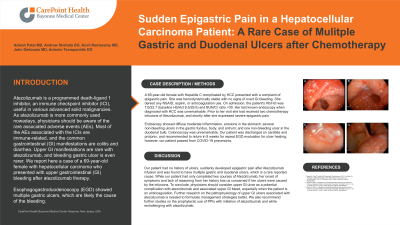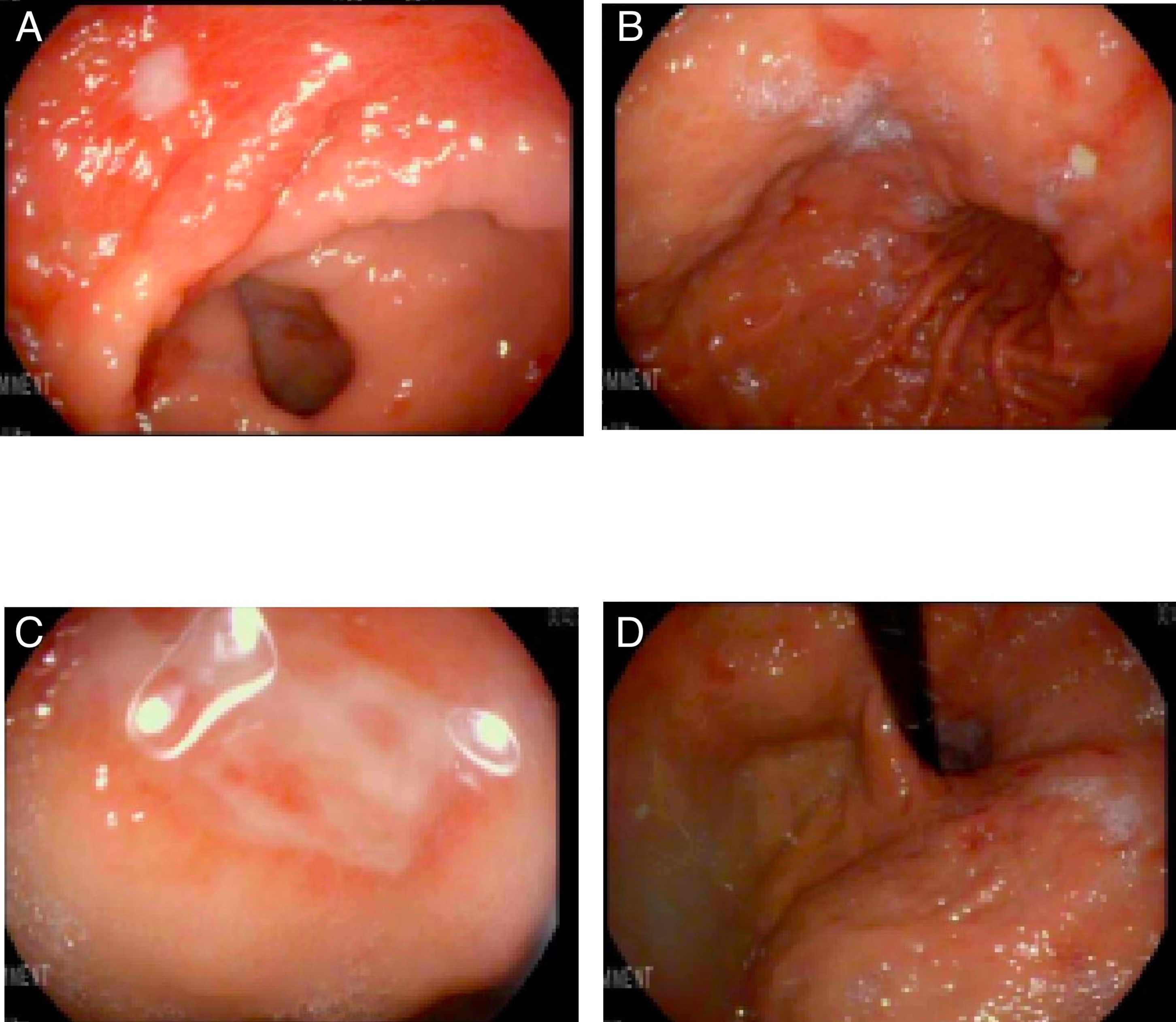Sunday Poster Session
Category: GI Bleeding
P0655 - Sudden Epigastric Pain in a Hepatocellular Carcinoma Patient: A Rare Case of Multiple Gastric and Duodenal Ulcers After Chemotherapy
Sunday, October 22, 2023
3:30 PM - 7:00 PM PT
Location: Exhibit Hall

Has Audio
.jpg)
Adwait Patel, MD
Bayonne Medical Center
BAYONNE, NJ
Presenting Author(s)
Adwait Patel, MD1, Andrew Shehata, DO2, Kovil Ramasamy, MD3
1Bayonne Medical Center, Harrison, NJ; 2CarePointHealth - Bayonne Medical Center, Bayonne, NJ; 3Bayonne Medical Center - CarePoint Health, Bayonne, NJ
Introduction: Atezolizumab is a programmed death-ligand 1 inhibitor, an immune checkpoint inhibitor (ICI), useful in various advanced solid malignancies. As atezolizumab is more commonly used nowadays, physicians should be aware of the rare associated adverse events (AEs). Most of the AEs associated with the ICIs are immune-related, and the common gastrointestinal (GI) manifestations are colitis and diarrhea. Upper GI manifestations are rare with atezolizumab, and bleeding gastric ulcer is even rarer. We report here a case of a 69-year-old male with hepatocellular carcinoma who presented with upper gastrointestinal (GI) bleed after atezolizumab therapy. Esophagogastroduodenoscopy (EGD) showed multiple gastric ulcers, which are likely the cause of the bleeding.
Case Description/Methods: A 69-year-old female with Hepatitis C complicated by HCC presented with a complaint of epigastric pain. She was hemodynamically stable with no signs of overt GI bleeding. She denied any NSAID, aspirin, or anticoagulation use. Her last known endoscopy when diagnosed with HCC was unremarkable. Prior to her visit she had received two chemotherapy infusions of Atezolizumab, and shortly after she expressed severe epigastric pain. Endoscopy showed diffuse moderate inflammation, erosions in the stomach; several non-bleeding ulcers in the gastric fundus, body, and antrum; and one non-bleeding ulcer in the duodenal bulb. Colonoscopy was unremarkable. Our patient was discharged on carafate and protonix, and recommended to return in 8 weeks for repeat EGD evaluation for ulcer healing; however, our patient passed from COVID-19 pneumonia.
Discussion: Our patient had no history of ulcers, suddenly developed epigastric pain after Atezolizumab infusion and was found to have multiple gastric and duodenal ulcers, which is a rare reported cause. While our patient had only completed two courses of Atezolizumab; her onset of symptoms and lack of reasoning from her history has us concerned if her ulcers were caused by the infusions. To conclude, physicians should consider upper GI ulcer as a potential complication with atezolizumab and associated upper GI bleed, especially when the patient is on anticoagulation. Further research on the pathophysiology of upper GI ulcers associated with atezolizumab is needed to formulate management strategies better. We also recommend further studies on the prophylactic use of PPIs with initiation of atezolizumab and while rechallenging with atezolizumab.

Disclosures:
Adwait Patel, MD1, Andrew Shehata, DO2, Kovil Ramasamy, MD3. P0655 - Sudden Epigastric Pain in a Hepatocellular Carcinoma Patient: A Rare Case of Multiple Gastric and Duodenal Ulcers After Chemotherapy, ACG 2023 Annual Scientific Meeting Abstracts. Vancouver, BC, Canada: American College of Gastroenterology.
1Bayonne Medical Center, Harrison, NJ; 2CarePointHealth - Bayonne Medical Center, Bayonne, NJ; 3Bayonne Medical Center - CarePoint Health, Bayonne, NJ
Introduction: Atezolizumab is a programmed death-ligand 1 inhibitor, an immune checkpoint inhibitor (ICI), useful in various advanced solid malignancies. As atezolizumab is more commonly used nowadays, physicians should be aware of the rare associated adverse events (AEs). Most of the AEs associated with the ICIs are immune-related, and the common gastrointestinal (GI) manifestations are colitis and diarrhea. Upper GI manifestations are rare with atezolizumab, and bleeding gastric ulcer is even rarer. We report here a case of a 69-year-old male with hepatocellular carcinoma who presented with upper gastrointestinal (GI) bleed after atezolizumab therapy. Esophagogastroduodenoscopy (EGD) showed multiple gastric ulcers, which are likely the cause of the bleeding.
Case Description/Methods: A 69-year-old female with Hepatitis C complicated by HCC presented with a complaint of epigastric pain. She was hemodynamically stable with no signs of overt GI bleeding. She denied any NSAID, aspirin, or anticoagulation use. Her last known endoscopy when diagnosed with HCC was unremarkable. Prior to her visit she had received two chemotherapy infusions of Atezolizumab, and shortly after she expressed severe epigastric pain. Endoscopy showed diffuse moderate inflammation, erosions in the stomach; several non-bleeding ulcers in the gastric fundus, body, and antrum; and one non-bleeding ulcer in the duodenal bulb. Colonoscopy was unremarkable. Our patient was discharged on carafate and protonix, and recommended to return in 8 weeks for repeat EGD evaluation for ulcer healing; however, our patient passed from COVID-19 pneumonia.
Discussion: Our patient had no history of ulcers, suddenly developed epigastric pain after Atezolizumab infusion and was found to have multiple gastric and duodenal ulcers, which is a rare reported cause. While our patient had only completed two courses of Atezolizumab; her onset of symptoms and lack of reasoning from her history has us concerned if her ulcers were caused by the infusions. To conclude, physicians should consider upper GI ulcer as a potential complication with atezolizumab and associated upper GI bleed, especially when the patient is on anticoagulation. Further research on the pathophysiology of upper GI ulcers associated with atezolizumab is needed to formulate management strategies better. We also recommend further studies on the prophylactic use of PPIs with initiation of atezolizumab and while rechallenging with atezolizumab.

Figure: A) Pre-pyloric stomach ulcer
B), D) Gastric body ulcer
C) Duodenal bulb ulcer
B), D) Gastric body ulcer
C) Duodenal bulb ulcer
Disclosures:
Adwait Patel indicated no relevant financial relationships.
Andrew Shehata indicated no relevant financial relationships.
Kovil Ramasamy indicated no relevant financial relationships.
Adwait Patel, MD1, Andrew Shehata, DO2, Kovil Ramasamy, MD3. P0655 - Sudden Epigastric Pain in a Hepatocellular Carcinoma Patient: A Rare Case of Multiple Gastric and Duodenal Ulcers After Chemotherapy, ACG 2023 Annual Scientific Meeting Abstracts. Vancouver, BC, Canada: American College of Gastroenterology.
